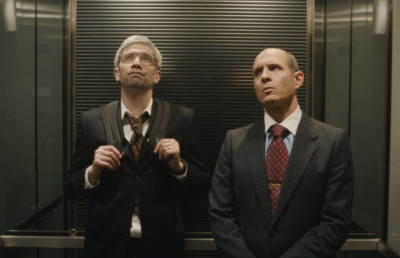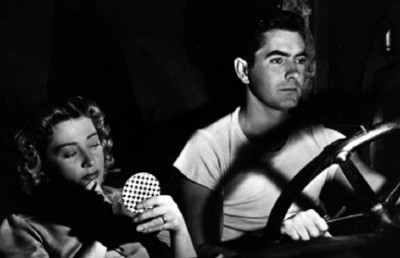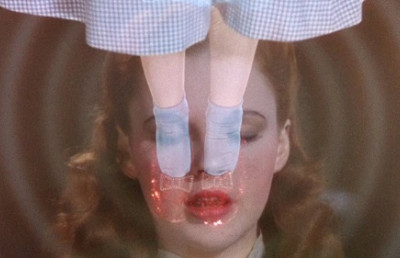Fantasia 2022: Reporting From the Frontlines
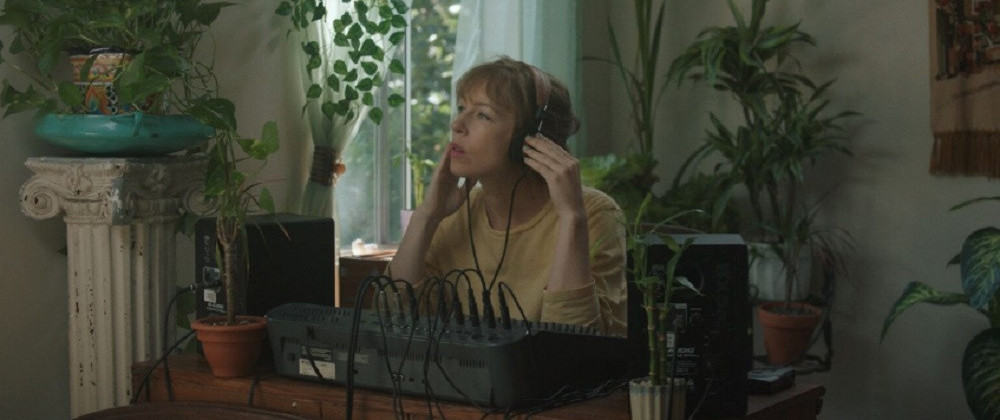
Compulsus (Tara Shore, 2021)
In my last year’s Fantasia report I wrote partly about rape revenge films. In an odd bit of continuity the first film I saw at the 2022 Fantasia was Compulsus (Tara Thorne), a rape revenge film of a different sort, for a variety of reasons. I was also pleasantly surprised to learn that it is from Nova Scotia, which joins Books of Blood (Brannon Braga, 2019), A Hobo with a Shotgun (Jason Eisener, 2011), and The Child Remains (Michael Melski, 2017) as horror films shot on that lovely Maritime province since My Bloody Valentine (1980). The film from last year that this comes closest to is Dana, a Spanish short film where a woman who escapes an assault attack decides to take the law into her own hands to mete out justice against abusive men that the law does not process. Compulsus is unique in that while it is a rape revenge film it is works remarkably well also as a lesbian romance where the love is born out of a shared sense of injustice. Lesley Smith (who looks like Montreal-based Slaxx director Elza Kephart) is awesome as Wally, a spoken word poet who slowly slips into a double life of female avenger/folk hero. Kathleen Dorian is her bisexual lover Lou, and her two straight besties are Mackenzie (Koumbie) and Kinnon (Kathryn Macormack). The other character of note is Wally’s sister Dev (Hilary Adams) who we only see in one scene but is a constant presence through phone messages with Wally.

Lesley Smith in Compulsus
What’s especially interesting about this film is how tightly focused it is around the viewpoint (and psyche) of the women. Shore directs the male characters to be largely invisible. The only men we see (although they are rarely ‘seen’) are potential aggressors who become victims of Wally’s vigilante attacks. And the men have their facial identity obscured by lighting, clothes they wear (a hoodie), darkness or obscured framing. Men are de-objectified. In a world run by men they are stripped of their usual power in this female-centric world. And director Tara Thorne sculpts every aspect of her film, from performance to character identity to visuals, to speak to the film’s strong political statement. Which amounts to what director Lucía Forner Segarra does in Dana: if the judicial and police systems which remain patriarchal at the core cannot control men from their violent tendencies toward women then women should take to their own defense. But more than defense, they should go on the offense to stop violence and abuse before it happens.
Wally is a fascinating character, a lesbian who has not herself been harmed by men but still holds men in contempt for the harm they have inflicted on all women, ones she knows or strangers. She does not have quite the personal mission that the Carey Mulligan character Cassandra has in the likeminded feminist vigilante film Promising Young Woman, who like Wally and Dana from Dana, have a more personal investment (Cassandra’s best friend committed suicide after an assault and Dana herself was attacked and killed her assailant in a riled up self-defense), yet she is very committed to the cause. She becomes obsessed with her cause and the function of her lover Lou is partly to act as the rational voice. Lou is excited by Wally’s commitment and agrees with her mission in principle, but not to the exclusion of a normal life. Near the end Lou saves Wally from an assault against a man gone wrong. While Wally nurses her bruised ribs in a hot tub they share an intimate bathtub exchange in a wonderfully written scene (as is the whole film). Wally tells Lou that she no longer feels alone in her mission, and that she receives countless communication and offers of support from women. Wally sees this not on a one-by-one basis but as a fully formed revolutionary movement. Lou admits her love for Wally but that she cannot continue watching Wally put herself at risk: “I love you, but I know I can’t do this.” But the “this” is what exactly? Their relationship, or her mission? Since Lou shows up in the final montage scene the suggestion is that while Lou and Wally may no longer be lovers, they are revolutionary partners in the fight against male oppression.
As noted, the film’s stringent political message is cleverly inscribed by director Shore’s decision to make Wally a spoken word artist. Having her be a spoken word artist gives Shore the advantage of using this narratively justified function to serve the film’s political agenda. The film opens on a stylishly lit close-up of Wally with a book in hand speaking to an audience. We don’t see the audience until the end of her talk which makes it a clever cold open. Only at the end of the scene do we learn that this is a performance reading at a spoken word café-bar. The second time we see Wally perform, about 35 minutes later, her performance is angrier and more politically forthright. The abruptness and bluntness of the tone even shocks her hard core friends. “I like a good manifesto. I AM a good manifesto.” Wally’s growth as an activist is registered through the evolution of her art ( a gesture which might even be meta comment on Tara Shore herself as a filmmaker). This ‘spoken word’ performance spills over from the diegetic stage to a broken fourth wall at the end. And spills out from Wally to all the other female characters, who one by one speak their activist voice directly into the camera, recalling the direct camera address racial epitaph scene from Do the Right Thing (Spike Lee, 1989) and the opening of Jane Campion’s Portrait of a Lady and the ending of Raoul Peck’s I Am Not Your Negro. As a set-up to this jarring Brechtian ending, Wally’s sister Dev arrives at her apartment showing markings of physical abuse on her face, which only confirms what Wally intuited all along: that Dev’s husband was abusing her.
She immediately leaves to confront Dev’s husband, who until now has remained an invisible presence only heard on the phone or indirectly (as are all men in the film, they are literally and figuratively shut up). She finds him in the kitchen, his face blocked by the framing. Wally wastes little time and shoots him in the stomach area (much of this occurs on the side of the frame). We never find out if the shot was fatal. Wally begins her spoken word/monologue inside the kitchen but a sharp edit takes us outside, where she continues her performance in the form of a direct address manifesto: “This is the new no upgraded and unraveling your grip on our bodies. We are ripping up the ground to get at you…We consent to nothing and to no one.” A montage follows of close-ups of each of the female characters, Mackenzie, Kinnon, Dev and Lou, each person finishing off the previous line of dialogue, creating a visual chain link of empowered women. The last line is reserved for Wally, framed in a stoic close-up: “We consent to nothing.” This final sequence is striking not only for its bluntness but for how it continues the performative nature of spoken word poetry but addressed directly to the hypothetical male audience. To all men everywhere. A series of powerful female gazes returned right back at the symbolic male audience with no remorse or compromise. A rallying cry not for help but for action.
What to do with the Dead Kaiju? (Satoshi Miki, 2022)

What to do with the Dead Kaiju?
I’ll begin by saying that this “non-kaiju” kaiju film gets credit for its “why-didn’t-anyone-think-of-this-before” premise? If you’ve seen enough glorious Kaiju films have you ever wondered, “what happens to all those dead Kaiju corpses littering the crumbled streets of Tokyo? I mean, I’ve never seen Godzilla pick up his latest conquest and carry it off or place it in a super-sized carcass incinerator. He just leaves the defeated foe behind and scampers back into the ocean. And yet in the next film Tokyo is clean, rebuilt and back to normal (actually, a sequel to this could be, “How do they rebuild Tokyo so quickly?”). This is the premise of What to do with the Dead Kaiju?”. As the film begins a kaiju who has been terrorizing Tokyo has mysteriously died, collapsed in a twisted mess of contorted limbs in a riverbed. After a brief period of happiness that this terrorizing force is dead, people begin to fret over the impact of this huge carcass, which is proving to be a different source of worry and danger: with the huge amount of gaseous build-up in its body, what will happen when it explodes? Will the released gasses be toxic for humans? Does it contain any nuclear aftermath?
In this aspect What to do with the Dead Kaiju? recalls the far superior Shin Godzilla, in how the government reaction to Godzilla’s presence proves less than efficient. That film was seen as a metaphor for how Japan reacted to the nuclear meltdown in the Fukushima powerplant in 2011 and the subsequent natural disasters. Here the different government bodies are either arguing over who will profit from the toxic clean-up or who will be tasked with disposal of the body: the Military, the Special Services, the Environmental Department, or the Waste department? The Science Minister thinks it might be a good chance to study Kaiju biology. Tourism sees this as a great opportunity to draw tourists from all over the world to Japan. The characters are pretty stock to the mix found in Shin Godzilla. Newlyweds Yukino Amane (Tao Tsuchiya) and Masahiko Ame (Gake Hamada), Yukino’s former lover Arata (Ryôsuke Yamada), now a member of the Special Task Force. Young rebel with dreads Ryo ‘Blues’ Aoshima (Joe Odagari), hapless, metaphor spewing Prime Minister Kan Nishiotachime (Toshiyuki Nishida), and energetic and opportunistic Environmental Minister Sayuri Renbutsu (Eri Fuse). Ironically the one thing I missed in this film, which in essence it can not provide, is a Kaiju destroy a foe and level Tokyo in the process!
Honeycomb (2022, Canada, Avalon Fast)

Director Avalon Fast
Honeycomb is a Canadian film quite unlike most Canadian films I’ve seen, but still identifiable as Canadian. Akin to what Saint Augustine said of time: “What then is time? If no one asks me, I know what it is. If I wish to explain it to him who asks, I do not know.” Or what Potter Stewart (1915–1985), the associate justice of the Supreme Court said when trying to label pornography under an obscenity law and was asked to define pornography, “I know it when I see it.” Canadian film can at times be a bit like that. Honeycomb is partly dreamlike and partly amateurish (with these two qualities feeding into each other); it is arty with a pulp rhapsody of (very white) teenage girlhood gone sour. It is Lord of the Flies by way of Yellowjackets, The Wilds and Spring Breakers. Five precocious and bored (a dangerous combination) girls on the verge of womanhood Willow (Sophie Bawks-Smith), Leader (Destini Stewart), Jules (Jillian Frank), Vicky (Mari Geraghty), and Millie (Rowan Wales), are itching to escape their small town for a summer of difference. They are tired of the same old summer routine and want to get away from everything, their parents (who remain unseen), their boyfriends (who appear vapid and dreary), their lousy summer jobs, any and all responsibility. At least for a few weeks. The car they drive to the cabin in is an old convertible, bathed in sunshine and hand held camera, observing the surroundings a la Virgin Suicides. The five friends echo the five Lisbon sisters from Virgin Suicides in their carefree attitudes and desire to break free from a stifling domesticity. Jules’ writing a note to her parents which appears as animated pink writing in her diary suggests the inner worlds of the Lisbon sisters, who also kept diaries as a form of self-expression. The film is full of bee imagery and metaphors, beginning as it does on a painting of a woman nestled within a beehive. The camera zooms out to reveal the painting hanging on the wall of the cabin in the woods which will become the girls’ temporary refuge. Willow is the ‘queen bee’ who finds the uninhabited cabin in the woods and convinces all her friends to leave everything behind for the cabin, their symbolic “hive”. They invite their boyfriends over but do so in a way which hides the location of the cabin. They use the boys as playthings, and to play live music in the cabin to drink and dance to. They come across some absinthe, a spirit known for its addictive, psycho-hallucinogenic properties. At first the journey feels like a 1960s commune, where they dress in equal red dresses in the fields to drink lemon-honey and talk about life. The boys come over to play loud out of tune rock music, filmed with muddy red lighting. The cabin adventure is broken a few times by edits to the boyfriends at a skateboard park talking about the “unfair” hegemony of the queen in the insect world. A strange discussion which exists only to comment on the “hive”. In fact all the discussions the boys have are indirectly about the girls, making their existence secondary to the girls (like an inverted failed Bechdel Test).
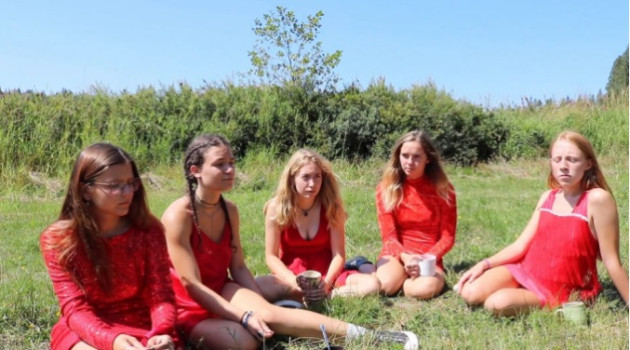
Honeycomb
Things take a turn for worse when the girls decide it necessary to have rules, so that they don’t descent into chaos (ironically given they came to the woods to break from conformity). Millie’s invited sister June (Jaris Wales) becomes the first victim of the new rules. The worse of them is the “suitable revenge” rule, which states that anyone who feels they are wronged in some way can come up with their own form of payback which they deem appropriate. So when June breaks Leader’s glasses, the justice is purely Old Testament: Leader gouges out one of June’s eyes. These absurd forms of justice are taken quite well by the girls, but when one of the boys finds out, he is horrified and calls them out for their psychotic behaviour. He’s right, but somehow we still are on the side of the girls. Honeycomb is not at all about the story or the actions but about the whole sensory experience, which director Fast achieves with a formal approach which oscillates between quiet moments of static camera shots in beautiful fields; slow zoom shots in or out of the space; red colored footage; breaks of first-person reality footage when they decide to film their adventures as a form of film diary; and natural sounds mixed with crude grunge rock and ambient tones and music. The film touches experimental narrative in some scenes, like the one where Willow is floating in a lake, filmed partially in soft focus, light shimmering off the water, as she recites a long poem about the ephemerality of time and how things exist largely in our memories (this poem is cited in the credits). The film does not end so much as stop with Willow sitting on a wooden chair in the fields talking to the camera about a new girl from a nearby town who has joined them. After the credits we have an extended outtake of little value and a meta moment of the writer-boom operator Emmett Roiko talking to the camera about how much he hated working on this film (an opaque allusion to Taste of Cherry?).
Identikit (1974, Italy, Giuseppe Patroni Griffi)

Identikit
As noted in my introduction to this issue, Identikit was one of several films featured at Fantasia to celebrate the recent Blu Ray release of Severin’s “House of Psychotic Women Rarities Collection” [a 5-disc set]. The box set was the brainchild of author, writer, programmer, director, producer, and publisher Kier-La Janisse, who also provided introductions to some of the selected films from the box-set.
Oddly given my reference to it above, Identikit is opaquely reminiscent of Abbas Kiarostami’s Taste of Cherry, where a man drives around rural Iran looking for someone to help him carry out his suicide by agreeing to bury him. Here it is a troubled, harried Elizabeth Taylor as Lise, who travels from London to Rome to perform in what seems a round about way what in her mind is a very specific task: find the right person in her mind that will kill her in a brutal way. The film gives no clues as to why she has this tragic fate in mind. And the audience only has hints until the end. But the path to get there is convoluted by Franco Arcalli’s non-linear editing, not unlike his editing in Bernardo Bertolucci’s The Conformist (1971), whose lighting and art direction it has much in common with (no doubt because both are filmed by DP Vittorio Storaro). While Lise moves forward toward her goal the Interpol and Italian police who are looking for her cause narrative detour flashbacks to moments being recalled by people who have interacted with Lise: like a mechanic who gives her a lift and tries to rape her; store clerks where she shopped, etc. The film is unique partly because of the forceful female lead and the way it borrows elements from several 1970s Italian filoni, notably the giallo (visiting foreigner, vague hints at death and murder, urban settings), poliziotteschi (terrorist bombing of a visiting diplomat by the Red Brigades, police using excessive force and brutality to elicit information from suspects, rape attempts) and Italian arthouse films (Franco Mannino’s piano based score recalls Giovanni Fusco’s music for Antonioni, thematic use of architecture and locations), some of which also employ popular genre models such as Investigation of a Citizen Above Suspicion and Il Conformista. The film draws great visual pleasure alone from the many location changes during its shooting, from malls to parks to museums to office buildings to public squares. The scene where the suicide/murder finally occurs is a major highlight, with Lise and her ultimate murderer Pierre shot in the stark silhouette of a large tree-filled park back lit with a huge bank of light and fog. The scene reminded me of the night time front of the castle scene between Marlene Dietrich’s Catherine the Great and a sentry in Scarlet Empress (Josef von Sternberg, 1934). A reticent Pierre lays on top and stabs Lise many times, although we only hear her moans and the stabs are kept below frame. In the follow-up tracking shot hours later the camera tracks by a group of policeman and Pierre staring down at where the corpse should be, but when the camera tilts to the grass Lise is nowhere to be seen. This ‘invisible’ gesture recalls the invisible tennis ball at the end of Blow Up, another arthouse remix of a popular genre. Does David Hemming pick up the mime’s invisible ball or not? The vagueness of Lise’s trauma which is suggested in incidental lines which express suppressed anger give the film its proto-feminist sensibility.
Il Demonio (Brunello Rondi, 1963)
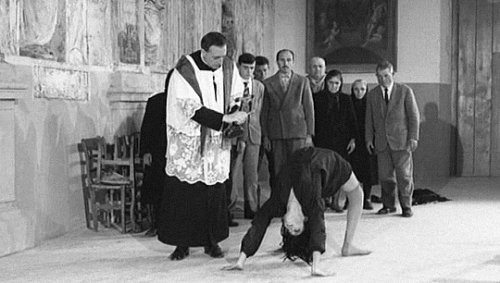
Il demonio
Il Demonio is a stark, gorgeously lit black & white masterpiece that renders the stifling religious conservatism of a small Southern town with alarming vividness. Rondi’s camera is restless, panning and zooming across landscapes and accusatory townsfolk who look upon the sexually anxious Purificata with fear and distrust. The Israeli actress Dahlia Lavi plays a young woman named Purificata who (unwisely in a Catholic town) desires a married man named Antonio (Frank Wolff). The frustrated Purificata resorts to pagan rituals to try and win him over. Her erratic behaviour convinces the town that Purificata is possessed by a demon, which leads to one of the signature moments in the film, an exorcism scene where Purificata contorts her body in a walk that prefigures the excised spider walk scene from the theatrical cut of The Exorcist (1973). After seeing Il demonio on the heels of seeing Identikit for the first time, it struck me how both characters, Lise and Purificata had similar life paths. Both characters experienced rape and/or violent male encounters for no reason other than being alive. Both characters were caught in a suffocating environment. For Purificata it was her sexuality that was being stifled by the religiously conservative village and for Lise it was her creativity or entire sense of self that was being stifled by a staid society. As a consequence, both characters are on a suicidal path that the audience does not really know about until they are hit in the face with it near the end. It is maybe clearer with Lise but I was struck in Il demonio the way Purificata kept putting herself in dangerous situations, culminating in her returning back to the village just when the whole town was out on a witch hunt! Both Purificata and Lise literally walk into the hands of their respective killers, Antonio and Pierre. It is the old Freudian Eros vs Thanatos drives playing out across the two films. For Purificata it is her Eros drive that kills her. And for Lise she renounces her Eros entirely for Thanatos. I found it fascinating how two very different films have this similar female character arc. The ending of Il demonio with the central character who the audience has largely identified and empathized with is needlessly killed at the end packed a similar wallop to the ending of Night of the Living Dead, where the sole survivor is mistakenly identified as a zombie and shot dead.
Topology of Sirens (Jonathan Davies, 2021)
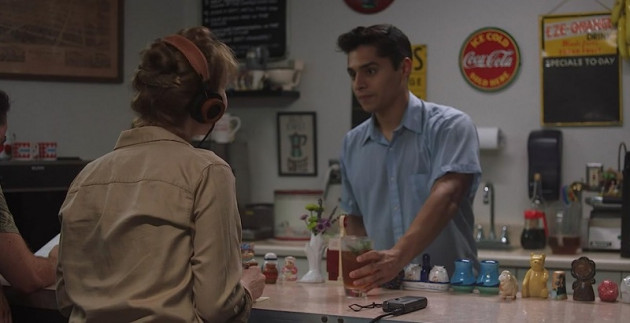
Topology of Sirens
Topology of Sirens is an interesting free form study of unusual spaces in Los Angeles frequented by a young woman/musician/scholar Cas (Courtney Stephens), who is motivated by little mysteries based on her family home. She finds a 17th century Hurdy Gurdy owned by her dead aunt which contains small audio cassettes hidden within which set her off on a journey of trying to discover what the audio tapes mean, and why her aunt owned that instrument. Meanwhile she spends time with her musician friends who play in local parks, cafes and home studios (the experimental composers Sarah Davachi and Whitney Johnson co-star). An early scene has a woman using her voice as one of many sounds through a sampler. Alongside the theme of music and sounds is nature. The cinematography takes in the lush natural spaces, woods, trees, lakes, coastal lines, islands, with sounds that may or may not be sourced. One five minute sequence that leaves Cas for two new characters is a highlight. The two women are in fact sirens, who move about the spaces, shot from light to dark, feeling and experiencing all the sights and sounds for the first time. They are played by two gorgeous women, Samantha Robinson, the love starved sociopath from The Love Witch, and Ernest Hemingway’s great granddaughter, Langley Hemingway. Courtney Stephens –who looks like indie director Josephine Decker– is one of those uncannily photogenic actors. The final long closing scene sees Cas framed from behind sitting at the top of a hill overlooking a pick-up game of softball. The sounds of the game, ball on bat, running, catching, do not always line up. Without stretching theme in any one direction the film feels motivated by a duality of analog vs digital, nature vs technology, music vs sound, ambient vs present.
Happer’s Comet (Tyler Taormina, 2021)
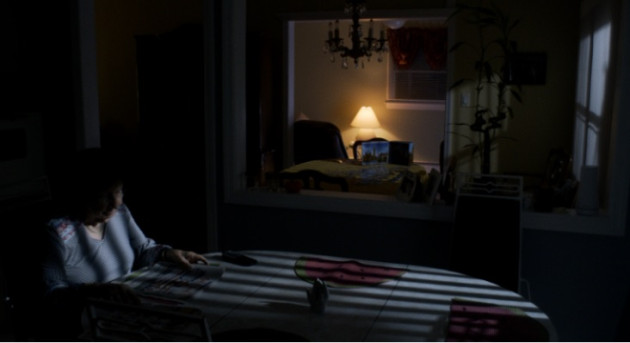
Unfortunately I missed the director’s intro which explained the context for this 60 minute feature. Without this intro my experience of the film was hampered as it felt too arbitrary as it moved from one character and location to another, without dialogue but only expressive sounds of the spaces. Everything takes place at night, beginning inside but soon moving into exterior spaces, roads, shops, parks, etc. Several of the strangers in a strange land are on moving toys, roller skates, with the jarring sound of hard plastic on cement and asphalt. A man peers back from his open car door at what, we don’t know. Until we see two friends pushing the broke down car. A bored mechanic standing in his empty body shop begins to do push-ups. A young woman ducks below a landing as a car passes, then walks up the steps to rollerblade away (was she breaking a Pandemic curfew?). Or, are people just so used to isolation they don’t want to encourage human contact? After the film my friend briefed me on the intro, which instructed us on how the film was made during the pandemic at a time where Tyler moved back to Long Island with his friends and so the people in the film are all his family or friends, which negated the issue of the COVID-19 bubbles. In a sly recourse to structure, the film begins on an extreme close-up of a piece of corn and ends in a corn field, where several people illogically seem to end up, tip toeing up the aisles to avoid being seen and heard from the others. Happer’s Comet is a strange experimental nocturnal visitation.
I had intended to conclude this report with a discussion of one of my most hotly anticipated screenings at Fantasia, Dario Argento’s latest film, Occhiali Neri (Dark Glasses). But I ended up having so much to say on it that I have set it aside for a stand alone review (forthcoming). Suffice to say for now that fans of the Italian maestro have grown accustomed to disappointment after his run of great films from the 1970s to the 1990s. While Occhiali Neri will not erase the memory of these recent failures, nor unabashedly recall Argento’s glory moments, it is an oddly effecting film with at least one brilliant scene (the opening solar eclipse scene), some truly bizarre set-pieces (a snake attack scene in a swamp anyone?), an unheard of (for Argento) sentimental character friendship between a blind prostitute and Chinese boy, many allusions to earlier Argento films, and one of the most innocuous killer motivations you’ll find in any giallo or slasher film (the killer sets off to kill our protagonist because she called him out for bad body hygiene!).
Read Interview with Honeycomb director Avalon Fast on Screen Slate




